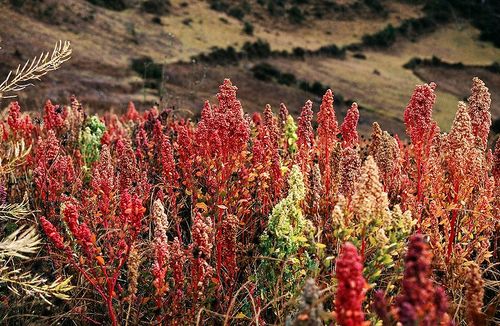For those who have a garden you might want to look into this, it's grown for the seeds.Quinoa: The Powerhouse SeedQuinoa (pronounced /ˈkiËnwÉ‘Ë/ or /kɨˈnoÊŠ.É™/, Spanish quinua, from Quechua kinwa), a species of goosefoot (Chenopodium), is a grain-like crop grown primarily for its edible seeds. It is a pseudocereal rather than a true cereal, or grain, as it is not a member of the grass family.
As a chenopod, quinoa is closely related to species such as beets, spinach, and tumbleweeds. Its leaves are also eaten as a leaf vegetable, much like amaranth, but the commercial availability of quinoa greens is currently limited.
https://en.wikipedia.org/wiki/Quinoa
~~~~~~~~~~~~~~~~~~~~~~~~~~~~~~~~~~~~~~~~~~
Quinoa greens 
Quinoa: The Powerhouse Seed
posted by
Terri Hall-Jackson Oct 21, 2010Commonly considered a grain, quinoa (pronounced keen-wah) is actually related to leafy green vegetables such as spinach, chard and beets. Once considered the
“mother seed” of the Incas, this South American native is a nutritional
powerhouse and its wide array of potential culinary uses makes it one of
the most practical foods to store in your pantry.Quinoa supplies all nine essential amino acids, making it a complete protein.
These are not easy to find in the plant world, making quinoa an
excellent option for vegetarians, vegans, and anyone interested in
adding non-meat proteins to their diet. In addition to being a protein,
quinoa is an excellent source for manganese, magnesium, iron, copper,
phosphorus and fiber. Quinoa is also naturally gluten-free, making it a great food for many who follow a gluten-free diet.Quinoa can be prepared as simply as couscous – add it to boiling
water or broth and let it sit for several minutes, and then fluff with a
fork. That preparation will give you quinoa in its simplest
presentation. This versatile seed can also be served as a breakfast “cereal” – simply add your favorite natural sweetener, along with some cinnamon and berries or chopped apples. It can be added to burritos, salads, a veggie burger or scrambled eggs. It can be sautéed with vegetables or given some
kick with Moroccan spices and raisins. Truly, the options are endless
and recipes are easy to find.Before cooking quinoa,
be sure to rinse it thoroughly to remove any residual resins that might
still be on the seeds. Otherwise, it can be quite bitter.Quinoa is available in several colors, most notably red, black and
more commonly, off-white. It is available in many grocery stores, both
packaged and in the bulk aisle. If you cannot find it in your
supermarket, it should definitely be at your local health food store.Related:
7 Grains to Add to Your Diet
Toasted Quinoa Edamame Salad
Wheat-Free Orange Quinoa Muffins
Basil Quinoa SaladRead more: https://www.care2.com/greenliving/quinoa-the-powerhouse-seed.html#ixzz138FrUxaQ ~~~~~~~~~~~~~~~~~~~~~~~

What is Quinoa Flour? Ask Annie
Dear Annie, I see quinoa flour at the health food store, and since it is gluten-free
and I am on a gluten-free diet, I’d like to buy it, but I don’t know
what to do with it, or what it is.
–Kathy, CODear Kathy, I, too, am on a gluten-free diet, and am a huge fan of quinoa flour. Its
flavor is so, so sweet! Quinoa is related to buckwheat and amaranth,
and whole it is a round seed the size of a sesame seed. It is
increasingly popular because it is high in protein and has a quick
cooking time and mild flavor. Sometimes it is called the “vegetarian caviar.”Quinoa has no gluten, its origin is South American, it is cultivated
in the United States, and for protein it has a complete amino acid
balance (rare to find outside of animal products).Whole quinoa is frequently used in hot cereal, side dishes, and served like rice. We have cooking tips on Care2.I personally use quinoa flour in muffins, pancakes, anything that
needs a grain, and I often combine it with gluten-free brown rice flour
and coconut flour (a very high fiber flour).Read more: https://www.care2.com/greenliving/what-is-quinoa-flour-ask-annie.html#ixzz138HStMEu





